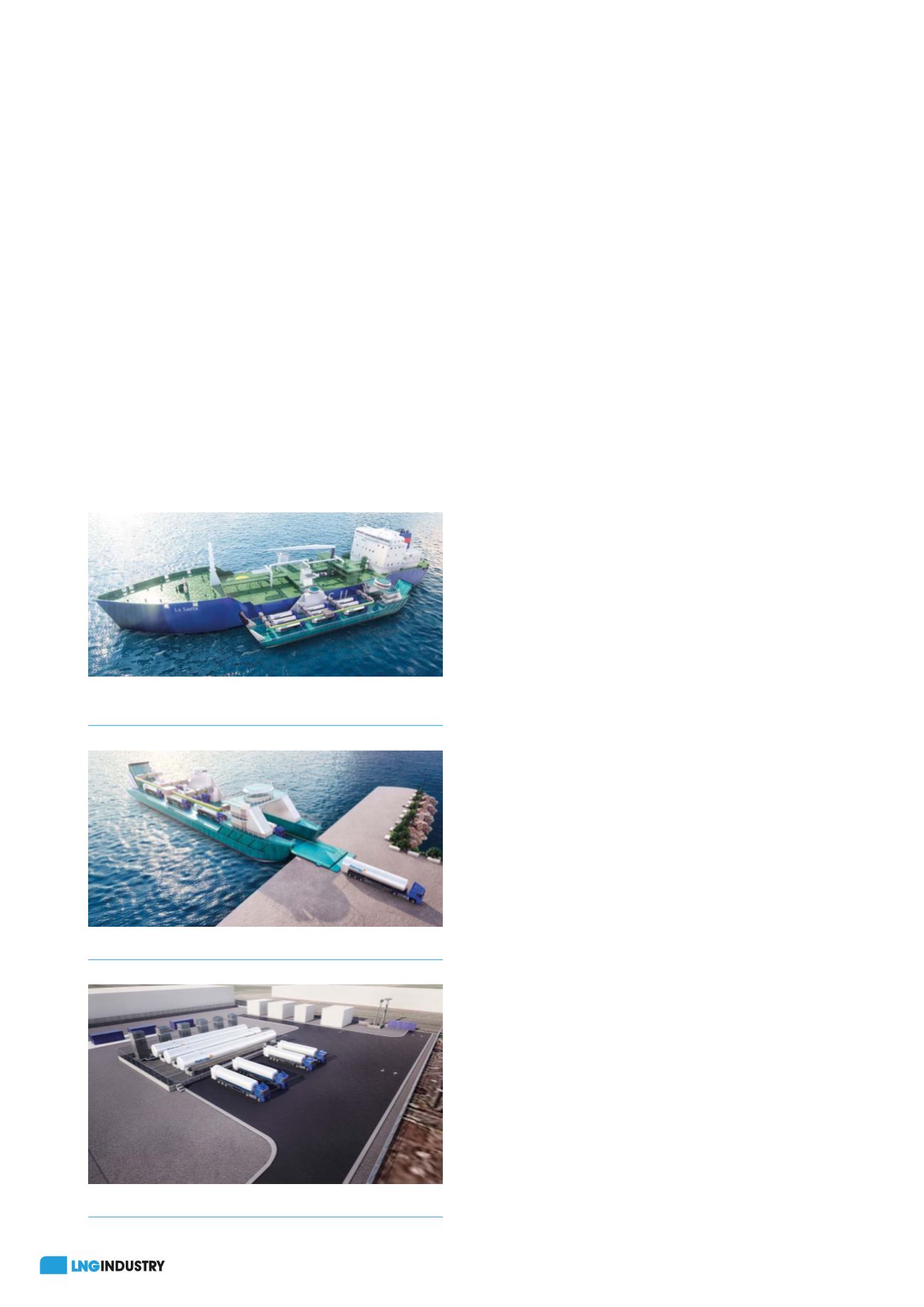
34
January 2020
engineering based on a vessel designed to carry LNG tanker
trucks with an onboard loading module to fill the trucks through
ship-to-ship (STS) transfer.
The LNGTC, with the loading module and the tanker trucks,
in combination with auxiliary infrastructures on the ground, is a
flexible, scalable solution that will meet the present and future
small and medium scale LNG market demands, allowing
end-users access to an economical, safe and environmentally
friendly energy source.
LNGTC
Schematically, the solution requires an LNG supply entity, such
as an LNG carrier, a floating storage unit (FSU), a floating storage
and regasification unit (FSRU), or an LNG export terminal, and
the patented LNGTC. The LNGTC has a deck area enabled to
arrange the tanker trucks, each in its corresponding loading
bay. It is also equipped with a connection module to the LNG
supply entity, an LNG loading module for the tanker trucks, a
distribution module that links the LNGTC connection module to
the LNG supply entity and to the loading module for the tanker
trucks, and access and exit ramps.
The connection module consists of the following:
z
Cargo hoses between the LNGTC and the LNG supply entity,
which are used for the transfer of LNG, nitrogen and gases
from the vaporisation of the LNG.
z
Boil-off gas (BOG) return line. This BOG can be also used for
the feeding of the engines or turbines of the LNGTC.
z
Nitrogen connection, which fills the tanks, pipes and hoses
with inert gas.
z
Instrumentation and control equipment to monitor and
control the transferred LNG, nitrogen and gas discharge.
LNG logistics and supply chain
The LNGTC sails between an LNG carrier position and the
Ro-Ro dock at the port, where it facilitates the exit and
subsequent return of tanker trucks for LNG distribution among
end customers. With this system, neither gas storage tanks
nor distribution facilities in the port are needed, since the
tanker trucks are autonomous to move inland to the customer
facilities.
The end customer may be one of the following: an electric
power generation plant that uses gas as a means of producing
energy, either through turbines or combustion engines; a
regasification and channeled distribution plant of gas to small
end consumers; an intensive gas industry; or even a small
consumer, such as a hotel complex or a hospital.
The LNG supply entity supplies the LNG to the LNGTC to
refill the tanks, performing this operation at sea or at an LNG
terminal under suitable metoceanic conditions.
Once this operation is finished, the LNGTC sails to the
nearest port and dismebarks the LNG tankers trucks, which will
drive by road to the final consumer. Once unloaded, the tanker
trucks drive back to the port, where they return to embark on the
LNGTC, waiting to be filled again when the LNGTC sails back to
the LNG supply entity.
Figures 1, 2 and 3 show the sequence of operations that
would be performed to supply the daily demand.
Certifications and patents
One of the highlights of the LNGonWheels project was
obtaining the ‘approval in principle’ (AiP) certification from the
American Bureau of Shipping (ABS), following its procedure of
new concepts evaluation.
Previously, a hazard identification (Hazid) study was chaired
and scribed by ABS.
In parallel, the patent application processes were started
and two Spanish patents have been granted in recognition of
the innovative nature of the LNGonWheels solution:
P 201730936 ‘Carrier for Carrying LNG Tanker Trucks’ and
P 201730935 ‘Maritime System for the Transport and
Distribution of LNG’.
The target was to patent a solution which significantly
reduced the total cost of investment associated with the
installation of new natural gas import infrastructures, providing a
cost-effective and environmentally friendly gas solution to small
and medium scale customers located in marine areas.
Further studies
With the support of SiPort 21, Naturgy has developed a
compatibility analysis of the LNG supply entity with the LNGTC to
carry out STS LNG transfers in different operating scenarios.
A dynamic analysis of the behaviour of the moored ships is
being performed (LNG carrier and LNGTC side-by-side). The scope
Figure 2.
LNG tanker trucks disembarking from the LNGTC.
Figure 1.
Feeding process of LNG tanker trucks on top of
the LNG tanker truck carrier (LNGTC).
Figure 3.
LNG satellite plant operations with tanker trucks.








